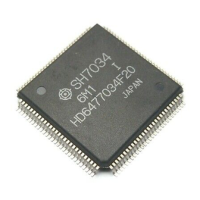234
When the MDF bit is set to 1 to select phase counting mode, the timer counter (TCNT2)
becomes an up/down-counter and the TCLKA and TCLKB pins become count clock input
pins. TCNT2 counts on both the rising and falling edges of TCLKA and TCLKB, with
increment/decrement chosen as follows:
Count
Direction Decrement Increment
TCLKA pin Rising High Falling Low Rising High Falling Low
TCLKB pin Low Rising High Falling High Falling Low Rising
In phase counting mode, selections for external clock edge made with the CKEG1 and CKEG0
bits in timer control register 2 (TCR2) and the counter clock selection made in the TPSC2–
TPSC0 bits are ignored. The phase counting mode described above takes priority. Settings for
counter clear conditions in the CCLR1 and CCLR0 bits in TCR2 and settings for timer I/O
control register 2 (TIOR2), timer interrupt enable register (TIER2), and timer status register 2
(TSR2) compare match/input capture functions and interrupts, however, are valid even in
phase counting mode.
• Bit 5 (Flag Direction (FDIR)): FDIR selects the setting condition for the overflow flag (OVF)
in timer status register 2 (TSR2). This bit is valid no matter which mode channel 2 is operating
in.
Bit 5: FDIR Description
0 OVF of TSR2 is set to 1 when TCNT2 overflows or underflows
(Initial value)
1 OVF of TSR2 is set to 1 when TCNT2 overflows
• Bit 4 (PWM Mode 4 (PWM4)): PWM4 selects PWM mode for channel 4. When the PWM4 bit
is set to 1 and PWM mode is entered, the TIOCA4 pin becomes a PWM output pin. 1 is output
on a compare match of general register A4 (GRA4); 0 is output on a compare match of general
register B4 (GRB4). When complementary PWM mode or reset-synchronized PWM mode is
set by the CMD1 and CMD0 bits in the timer function control register (TFCR), the setting of
this bit is ignored in favor of the settings of CMD1 and CMD0.
Bit 4: PWM4 Description
0 Channel 4 operates normally (Initial value)
1 Channel 4 operates in PWM mode

